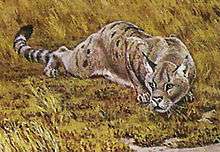Pseudaelurus
| Pseudaelurus Temporal range: Miocene, 20–8 Ma | |
|---|---|
 | |
| Pseudaelurus jawbone from the Staatliches Museum für Naturkunde Stuttgart, Germany | |
| Scientific classification | |
| Kingdom: | Animalia |
| Phylum: | Chordata |
| Clade: | Synapsida |
| Class: | Mammalia |
| Order: | Carnivora |
| Family: | Felidae |
| Genus: | Pseudaelurus Gervais, 1850 |
| Species | |
| |
Pseudaelurus is a prehistoric cat that lived in Europe, Asia and North America in the Miocene between approximately 20 and 8 million years ago. It is an ancestor of today's felines and pantherines as well as the extinct machairodont saber-tooths, and is a successor to Proailurus. It originated from Eurasia and was the first felid to reach North America, when it entered the continent at about 18.5 Ma ending a 'cat-gap' of 7 million years.[1][2] The slender proportions of the animal, together with its short, viverrid-like legs, suggest that it may have been an agile climber of trees.[3]
Species and distribution
Europe
The first and most primitive species Pseudaelurus turnauensis (=Pseudaelurus transitorius) from the early Miocene was about the size of a domestic cat and probably evolved directly from the Oligocene Proailurus. The European Pseudaelurus turnauensis gave rise to additional species. Pseudaelurus lorteti was lynx-sized and the even larger Pseudaelurus quadridentatus weighed about 30 kg and was approximately the size of a cougar. The latter showed a trend towards slightly enlarged upper canines, indicating that it may have given rise to the later saber-toothed machairodontines. Unexpectedly, the early Pseudaelurus turnauensis survived until 8 million years ago, at which time it is recorded in Germany, whereas the more derived Pseudaelurus lorteti and Pseudaelurus quadridentatus died out 2 million years earlier.[4] A fourth European species is described as Pseudaelurus romieviensis, smaller than P. quadridentatus but larger than P. lorteti.[2]
Asia
P. turnauensis is also recorded in Saudi Arabia from the early Miocene. P. lorteti is also recognized from the middle Miocene of Asia (Jiangsu, China), where two additional species, Pseudaelurus guangheensis from the middle Miocene of Gansu (China) and Pseudaelurus cuspidatus from the middle Miocene of Xinjiang (China) are reported.[2]

North America
Pseudaelurus intrepidus from the Early to Late Barstovian of North America was a relatively large species, overlapping in size with the European P. quadridentatus. A second large North American species from the Early and Late Barstovian was Pseudaelurus marshi. Pseudaelurus stouti (originally described as Lynx stouti) also from the Early and Late Barstovian was a very small and slender form of the genus. Pseudaelurus aeluroides with only a type specimen from Early Barstovian from Nebraska is not well studied, but may be conspecific with P. marshi. A species Pseudaelurus validus, from the late Hemingfordian of New Mexico was described in 2001. This species overlaps in size with P. intrepidus, P. marshi and P. quadridentatus.[5] Recently (2003) an additional North American species Pseudaelurus skinneri from the Late Hemingfordian of Nebraska was described. This species is smaller than P. validus and overlaps in size with the Eurasian species P. lorteti, P. cuspidatus and p. guangheensis.[2]
Footnotes
References
- Augusti, Jordi (2002). Mammoths, Sabertooths and Hominids: 65 Million Years of Mammalian Evolution in Europe. New York: Columbia University Press. ISBN 0-231-11640-3.
- Christiansen, Per (2008). "Phylogeny of the great cats (Felidae: Pantherinae), and the influence of fossil taxa and missing characters". Cladistics. 24 (6): 977. doi:10.1111/j.1096-0031.2008.00226.x.
- Gervais, Paul (1850). "Zoologie et paléontologie françaises. Nouvelles recherches sur les animaux vertébrés dont on trouve les ossements enfouis dans les sol de le France et sur leur comparaison avec les espèces propres aux autres regions du globe". Zoologie et Paléontologie Françaises. 8: 1–271.
- Rothwell, Tom (2001). "A partial skeleton of Pseudaelurus (Carnivora, Felidae) from the Nambé Member of the Tesuque Formation, Española Basin, New Mexico". American Museum Novitates. 3342: 1–31. doi:10.1206/0003-0082(2001)342<0001:APSOPC>2.0.CO;2. uri:http://hdl.handle.net/2246/2895.
- Rothwell, Tom (2003). "Phylogenetic Systematics of North American Pseudaelurus (Carnivora: Felidae)". American Museum Novitates. 2403: 1–64. doi:10.1206/0003-0082(2003)403<0001:PSONAP>2.0.CO;2.
- Tedford, R. H.; Galusha, T.; Skinner, M. F.; Taylor, B. E.; Fields, R. W.; Macdonald, J. R.; Rensberger, J. M.; Webb, S. D.; and Whistler, D.P. (1987). "Faunal succession and biochronology of the Arikareean through Hemphillian interval (late Oligocene through earliest Pliocene epochs) in North America". in Woodburne, M. O. Cenozoic mammals of North America: Geochronology and biostratigraphy. Berkeley: University of California Press. pp. 153–210. ISBN 0-520-05392-3.
- Turner, Alan (1997). The Big Cats and their fossil relatives. New York: Columbia University Press. ISBN 0-231-10228-3.